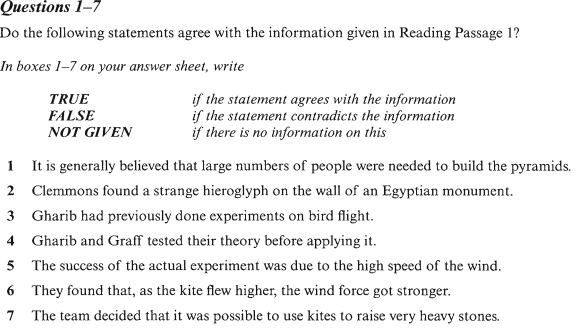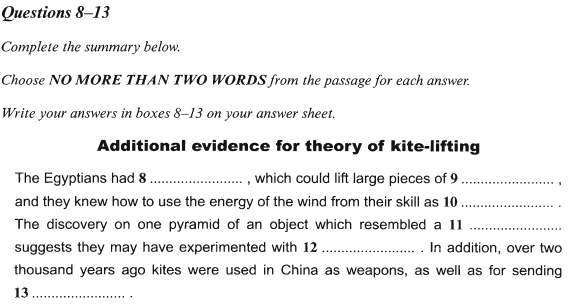剑桥雅思7阅读:Test4雅思阅读PASSAGE 1真题+答案+解析
发布时间:2021-12-30 关键词:剑桥雅思7阅读:Test4雅思阅读PASSAGE 1真题+答案+解析READING PASSAGE 1
You should spend about 20 minutes on Questions 1-13, which are based on Reading Passage 1below. .
Pulling strings to build pyramids
No one knows exactly how the pyramidswerebuilt,Marcus Chown reckons the answer could be 'hangingin the air'.
The pyramids of Egyptwere built
morethan three
thousandyears ago, andno one
knows how. The
conventional picture is that tens of thousands of slavesdragged stones on sledges. But there is no evidence toback this up. Now a Californian software consultantcalled Maureen Clemmons has suggested that kitesmight have been involved. While perusing a book on
the monuments of Egypt, she noticed a hieroglyph that showed a row of men standing inodd postures. They were holding what looked like ropes that led, via some kind ofmechanical system, to a giant bird in the sky. She wondered if perhaps the bird wasactually a giant kite, and the men were using it to lift a heavy object.
Intrigued, Clemmons contacted Morteza Gharib, aeronautics professor at the CaliforniaInstitute of Technology. He was fascinated by the idea. 'Coming from Iran, I have a keeninterest in Middle Eastern science,' he says. He too was puzzled by the picture that hadsparked Clemmons's interest. The object in the sky apparently had wings far too short andwide for a bird. 'The possibility certainly existed that it was a kite,' he says. And since heneeded a summer project for his studen Emilio Graff, investigating the possibility of usingkites as heavy lifters seemed like a good idea.
Gharib and Graff set themselves the task of raising a 4.5-metre stone column fromhorizontal to vertical, using no source of energy except the wind. Their initial calculationsand scale-model wind-tunnel experiments convinced them they wouldn't need a strongwind to lift the 33.5-tonne column. Even a modest force, if sustained over a long time,would do. The key was to use a pulley system that would magnify the applied force. Sothey rigged up a tent-shaped scaffold directly above the tip of the horizontal column, withpulleys suspended from the scaffold's apex. The idea was that as one end of the columnrose, the base would roll across the ground on a rolley.
Earlier this year, the team put Clemmons's unlikely theory, to the test, using a 40-square-metre rectangular nylon sail. The kite lifted the column clean off the ground. 'We wereabsolutely stunned,' Gharib says. 'The instant the sail opened into the wind, a huge forcewas generated and the column was raised to the vertical in a mere 40 seconds.'
The wind was blowing at a gentle 16 to 20 kilometres an hour, litle more than half whatthey thought would be needed. What they had failed to reckon with was what happenedwhen the kite was opened. There was a huge initial force - five times larger than the steadystate force,' Gharib says. This jerk meant that kites could lift huge weights, Gharib realised.Even a 300-tonne column could have been lifted to the vertical with 40 or so men and fouror five sails. So Clemmons was right: the pyramid builders could have used kites to liftmassive stones into place. 'Whether they actually did is another matter,' Gharib says. Thereare no pictures showing the construction of the pyramids, so there is no way to tell whatreally happened. 'The evidence for using kites to move large stones is no better or worsethan the evidence for the brute force method,' Gharib says.
Indeed, the experiments have left many specialists unconvinced. 'The evidence for kite-lifting is non-existent,' says Willeke Wendrich, an associate professor of Egyptology at theUniversity of California, Los Angeles.
Others feel there is more of a case for the theory. Harnessing the wind would not havebeen a problem for accomplished sailors like the Egyptians. And they are known to haveused wooden pulleys, which could have been made strong enough to bear the weight ofmassive blocks of stone. In addition, there is some physical evidence that the ancientEgyptians were interested in flight. A wooden artefact found on the step pyramid atSaqqara looks uncannily like a modern glider. Although it dates from several hundredyears after the building of the pyramids, its sophistication suggests that the Egyptians mighthave been developing ideas of flight for a long, time. And other ancient civilisationscertainly knew about kites; as early as 1 250 BC, the Chinese were using them to delivermessages and dump flaming debris on their foes.
The experiments might even have practical uses nowadays. There are plenty of placesaround the globe where people have no access to heavy machinery, but do know how todeal with wind, sailing and basic mechanical principles. Gharib has already beencontacted by a civil engineer in Nicaragua, who wants to put up buildings with adoberoofs supported by concrete arches on a site that heavy equipment can't reach. His ideais to build the arches horizontally, then lift them into place using kites. 'We've given himsome design hints,' says Gharib. 'We' re just waiting for him to report back.' So whetherthey were actually used to build the pyramids or not, it seems that kites may make sensibleconstruction tools in the 21st century AD.


师资点题剑桥雅思7阅读解析:
READING PASSAGE 1
文章结构
体 裁:议论+说明文
主 题:探讨相关经多年研究发现古代埃及人建造金字塔的全新理念及方式
段落概括
段金字塔有可能是通过空中方式建造的。
第二段通过研究象形图案发现图像中的风筝线索。
第三段经讨论开始准备按照该原理进行仿制试验。
第四段仿制试验的具体要求及准备过程。
第五段次试验获得成功。
第六段次试验的过程描述及的深入探讨。
第七段一些对此试验提出异议。
第八段另外一些持不同看法,他们认为古埃及人有能力完成此事。
第九段该想法及试验对于现实生活的人类也会产生有价值的作用。




